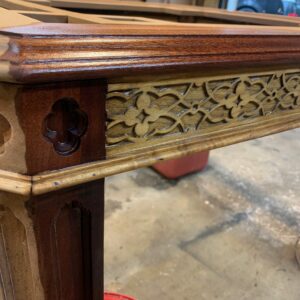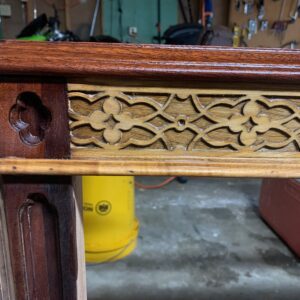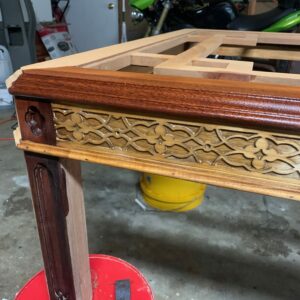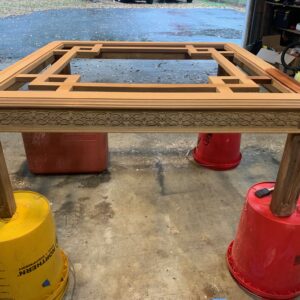Discussion Forum
Get It All!
UNLIMITED Membership is like taking a master class in woodworking for less than $10 a month.
Start Your Free TrialCategories
Discussion Forum
Digital Plans Library
Member exclusive! – Plans for everyone – from beginners to experts – right at your fingertips.
Highlights
-
Shape Your Skills
when you sign up for our emails
This site is protected by reCAPTCHA and the Google Privacy Policy and Terms of Service apply. -
 Shop Talk Live Podcast
Shop Talk Live Podcast -
 Our favorite articles and videos
Our favorite articles and videos -
E-Learning Courses from Fine Woodworking
-
-
 Fine Woodworking New England Event
Fine Woodworking New England Event -

















Replies
Sorry you are not getting a lot of responses. I think it may be because there are no right answers for you. Think about what you want it to look like when it's done. Is there black in the inlays? If so leave it. I like the look of the black in the inlay, but it's not going to sit in my living room.
To match or not match is also an artistic choice. If you decide to match, gel stains or dyes are your friend.
The white stuff looks like dried leftovers from whatever you have done so far. Try wiping it away with mineral spirits or acetone.
Best of luck.
Thank you for your response!
The black is on the edges of the inlay and looks like it's dark stain soaked into the edge of wood so it will be very difficult to fully remove? I am not too concerned about it because it seems like it will be a really big pain plus there are already some areas of that inlay starting to peel and flake away so it seems like I need to be gentle :/
Yes I'd like to match all three of the woods. I was looking into some water based dye's. I just hate that I don't have any practice material, but I will just go slow and slowly build with very diluted dyes.
I took a little brush and some mineral spirits to hopefully make those little white bits go away! Waiting for it to dry to see if that worked.
Sometimes questions like yours are difficult to answer from pictures and not knowing what skills and tools you have available. I can't tell if the table is partially stripped or partially refinished from the photos. The white areas you refer to are out of focus when I expand the photos so I can't begin to say what they are. I have no idea of the age of the piece, where it was made or the glue used to assemble it, all of which can affect how you proceed. Then the mere fact you say the piece is a family heirloom and has sentimental value and I cringe at the thought of giving the wrong advice. I will say the piece does seem very well made and worth doing right even before the story behind it.
With all that said, and add the disclaimer that I don't consider myself a finishing guru by any means, I will offer some advice. Starting with go slow, test new practices in small areas before attacking the entire piece. By all means I think you need to remove the white residue, what is it? If you can't tell being in the same room with it we certainly can't looking at low resolution pictures. Is it dust? try using a compressor to blow it away with air. If you don't have a compressor pick up a can of compressed air at an office supply or electronics store. If that does not work it's probably chemical residue from the stripping process try brushing it away with small stiff nylon brushes and some solvent, which one depends on what the original finish was, try mineral spirits, naphtha or denatured alcohol if you can get it. A Dremel tool with a nylon brush may help as well, but if you do this with solvent be sure to wear goggles, not safety glasses, but goggles like you wore in HS chemistry class and go slow.
The black stains? I have no idea how you would remove them give the location, but you could try the previous brushes and solvents but I hope you don't have to work for a living because I don't see this happening quickly. There are bleaches that may do the job but read the part about going slow and testing in small areas again.
Once you are ready to refinish, more challenges await you. The aforementioned gel stains do have their advocates, but I personally have never had much success with them and can't imagine using them in such intricate areas. Dyes are also popular with pros to adjust colors but can be tricky to use as well for those not familiar with them. They come in two forms alcohol and water based, the alcohol based dyes are very tricky to use because they dry so quickly plus they also fade quicker in sunlight so, if you plan on using dyes I would stick with water based dyes, but practice on some similar scraps first. The method many pros use to blend dissimilar woods is a process called glazing which in simple terms is a tinted finish that can be built up gradually to adjust and blend colors. Unfortunately these work best when sprayed and I don't know if than is feasible for you.
I would suggest you pickup a good book devoted to finishing. One of my favorites is Jeff Jewitt's titled FINISHING its available here in the Taunton Press store or Amazon and it is worth the time to read if you truly want to do your best.
I truly wish you the best and hope this turns out well for you and your family.
Thank you for your response!
The table is fully stripped and the wet look in the pictures is from me applying some mineral spirits to show the wood.
I'm sorry for the pictures not being that great. I was having trouble uploading full resolution photos from my phone with this sites limit on file size and amount of pictures.
Don't worry about giving wrong advice! I'm just very happy to receive any! I usually lurk on these types of sites and watch a bunch of youtube videos but I thought it would be nice to ask you experienced people what y'all would do!
My mom worked at a fine furniture store and this was one of the pieces we had in our living room while growing up. It is probably 30 years old?
I hope the white residue is dust, I realized that I didn't even upload the picture that showed it in detail because I couldn't do more than 5 pictures. But, I just scrubbed an area with a nylon brush and mineral spirits hoping that it's just soft grain pockets filled in by leftover sanding material.
Yeah I think the black edges are going to have to stay. I stripped the table with citristrip wrapped in plastic half-day/overnight 4 times. I think the stain is just embedded in the edges of that wood. And now the inlays are very brittle and breaking off and coming unglued in a few areas.
Okay! I will purchase some water based dyes, probably from General Finishes and go really slow! I don't have any scraps of that type of wood. Do you have any guesses on what that type of wood it is? Looks like 3 different types to me between the top, the inlays, and the legs. I think I just want to match the top and the inlay to the legs. The legs looks to might be mahogany/red mahogany? I own a compressor and would just need to buy an hlvp gun. I am not super skilled with that type of stuff but I used to be a commercial painter and have sprayed thousands of gallons of paint so I will learn on some cardboard! lol if that's what you think I should do. And, is it best to spray on a finish coat? Is Arm-A-Seal something nice to spray in this situation?
I will purchase that book on Amazon because I do like woodworking and refinishing reclaimed items. Thank you for that suggestion!
Please let me know if uploading some different photos with better resolution would help. And please ask any questions and correct me whereever you see fit! Thank you for your time and patience!
I think esch5995 has some good advice. Frankly, I like the contrasting colors and would probably apply a clear finish without stain and enjoy the contrast. But that is just my opinion. You have to do what you like best. The dark color on the edges of the carvings gives a nice shadow effect. If the color is stable, leave it. Color matching can be difficult and time consuming. And, the fact that you don't have any scraps of the same wood for testing makes it even more difficult. That would influence my decision.
First, you've done an amazing job stripping that table. Second, I echo much of what's been said above. I've done my fair share of refinishing and it's an art (and I'm not an artist). Are the black edges end grain that has soaked in more stain/dye because they're more porous? Hard to tell on the white stuff. Could be dust, could be stripping residue. Perhaps have at it with compressed air (start low pressure) a stiff bristle brush, and a dental pick.
Seal-A-Cell and Arm-R-Seal are my go-to products. I prefer Trans Tint dyes with either water or alcohol but be aware that the former is going to raise the grain and you'll have to knock it back down. As beasleyseven said, gel stains are your friend for evening out color. I don't use them on raw wood. Sand to 220, dye with Trans Tint in water. After it's dry, knock it down, lightly, with 220. Seal with Seal-A-Cell, let it dry. Hit it lightly with 220 again. Note that the end grain will take up more dye than flat grain. If you want to keep the end grain from getting darker, sand it to a higher grit (320-600). Now use your gel stain/glaze to even out the color, highlight, or age areas. Let it dry and top coat with either Arm-R-Coat or spray lacquer (I use a rattle can of Minwax satin or Mohawk satin when I can get it). And before you go to town doing this, try it on a scrap if you have one, or inconspicuous area (bottom?). With the exception of the lacquer, everything is wipe on. I'm not paid to promote any of these products, lol. I've also called Jeff Jewett at Homestead Finishing (Trans Tint) when I've had questions. That's basically one of his finishing regimes above that I've used and adapted for different looks. He's a great guy, incredibly helpful, and has probably forgotten more about finishing and refinishing than I'll ever know!
This forum post is now archived. Commenting has been disabled